
| Go to Allan's Page | Our Home Page | Holidays Home Page | British Canals Page | Go to Deb's Page |
| FlickR album of these photos | Part 1: The River Rhone |
After a wonderful week on the Rhone, the TGV had brought us to Paris where we joined the Viking Fjorgyn. This ship was almost identical to the Viking Buri upon which we had spent the previous week, and we were even in the same number cabin, so we felt totally at home straight away except that the crew members were of course all different. The Fjorgyn is also a few feet shorter than the Buri, which allows it to dock at a prime location less than a mile from the Eiffel Tower. The traffic from the railway station to the ship was terrible. It seems that all the wide streets of Paris have been divided into lanes reserved for buses, lanes reserved for bicycles, lanes reserved for taxis, etc, which are all mostly empty, so that there is not enough room left to allow the ordinary traffic to flow properly. As a result there are miles of stationary or ultra-slow traffic, with most of it emitting fumes while the vehicles sit there idling; is almost certainly less environmentally friendly than allowing the traffic to flow properly. At least it gave us plenty of opportunity to look at the sights through the coach window, We spent more time sightseeing later that day on foot, and the following morning by coach.
We were pleased to find that our luggage had also made the journey successfully - although a strange fault meant that the lock on one of the suitcases had somehow changed its combination so that we could not open it; luckily as it was just a 3-digit number so it took me less than an hour to work through all the numbers, trying one at a time until to our great relief it sprung open.
We soon realised that all the passengers on the ship were American, apart from ourselves and 6 others. That was not a problem in itself, but perhaps explained why most the week's activities were very American-dominated; for example most of the tour guides tailored their descriptions around the American viewpoint and were even in some cases openly hostile to the British (blaming them for defeating Napoleon at Waterloo, for allowing Germany to invade France in WWII, for opposing the Americans during their War of Independence, and of course more recently for Brexit). That night however we made a great many friends on-board the ship; in particular over dinner we formed a strong friendship with a group of 4 Americans who were great company and even seemed to share our sense of humour, such that we resolved to dine (and drink) together as a group all week. One of them had a birthday that week, and 2 of the others had a wedding anniversary, so the celebrations were many and enthusiastic.
After dinner that night was a really good presentation called 'Parlez Vous Fromage?' at which we all learned some useful French phrases and tasted a number of absolutely delicious cheeses. Then overnight the ship took us down-river to the pretty little village of La Roche-Guyon. The tiny landing stage there must have needed careful manoeuvring to dock the ship without waking all the passengers! At last we had some good weather, and we had a simply delightful stroll around the village.
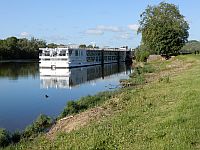 |
 |
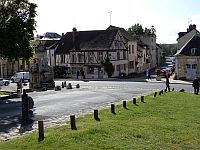 |
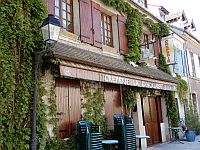 |
Moored at the tiny landing stage |
Debbie can finally enjoy some sunshine |
The village was very pretty |
We wished this little cafe had been open when we arrived |
The Chateau was particularly impressive, being built right back against the cliff with reputedly a secret passage up inside the hill to the tower, and we would have been tempted to take a tour of its rooms if we had had time. Instead we opted to walk up the hill to find a bakery that was shown on the map; it was a lovely walk but we never did find the bakery! On our return down the hill, the Chateau gardens were particularly restful and very beautiful, before we made our way back to the ship later that morning.
While we had been ashore, several passengers had taken part in a painting workshop. Although we had avoided the workshop itself, we arrived back on board in time for the excellent follow-on talk about the many painters who had loved the Seine valley including Pissaro, Renoir, van Gogh, and of course Monet whose gardens we were looking forward to visiting that afternoon.
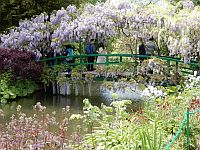 |
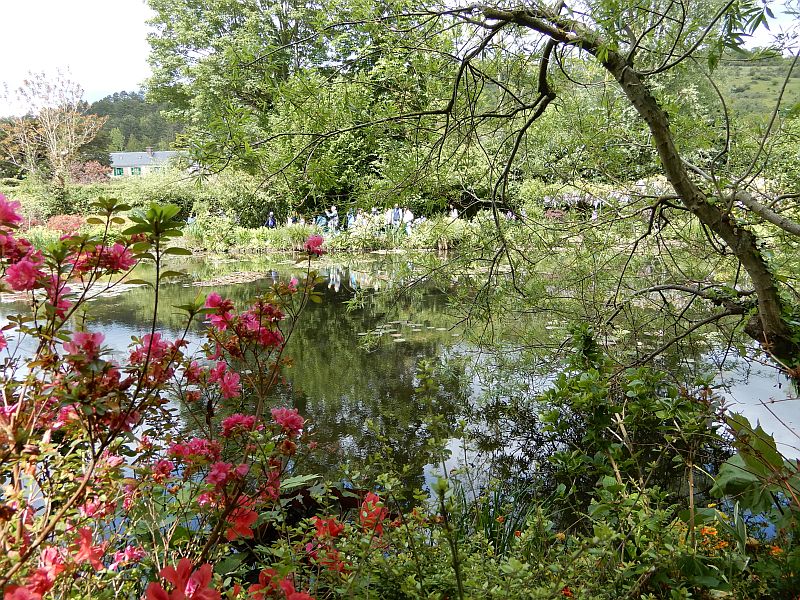 |
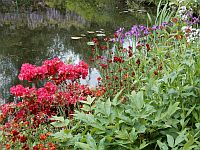 |
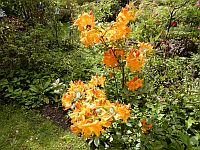 |
 |
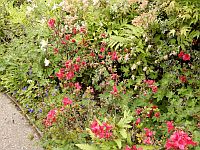 |
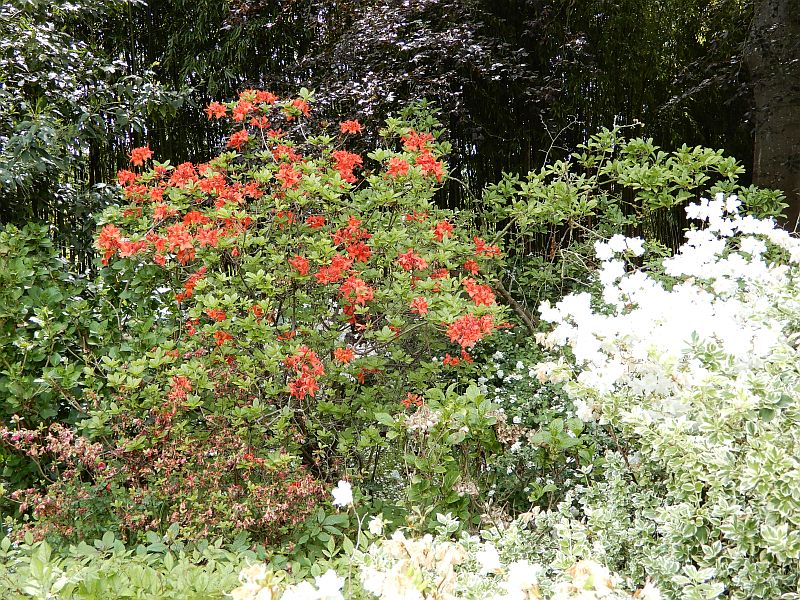 |
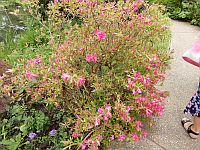 |
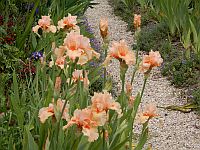 |
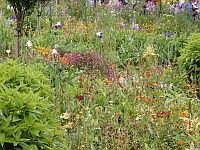 |
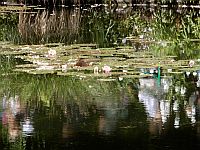 |
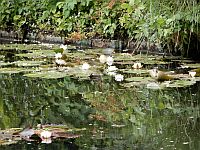 |
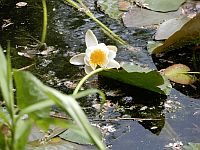 |
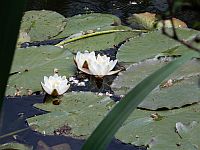 |
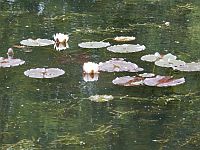 |
The flowers in Monet's garden were amazing - especially, of course, the water-lilies (which had been only buds the day before our visit) |
||||
The visit to Monet's garden at Giverney was for us one of the highlights of the week, Our guide here was excellent, and as she had worked in the gardens for a few years she was extremely knowledgeable about the thousands of beautiful flowers that we saw there. We were extremely lucky because the afternoon sunshine not only helped to fill the atmosphere with scent but had also brought the water-lilies out into flower that very day. As well as the gardens we also visited Monet's house, and couldn't resist buying a couple of small souvenirs in their gift shop before pausing there for a rest and a cup of coffee.
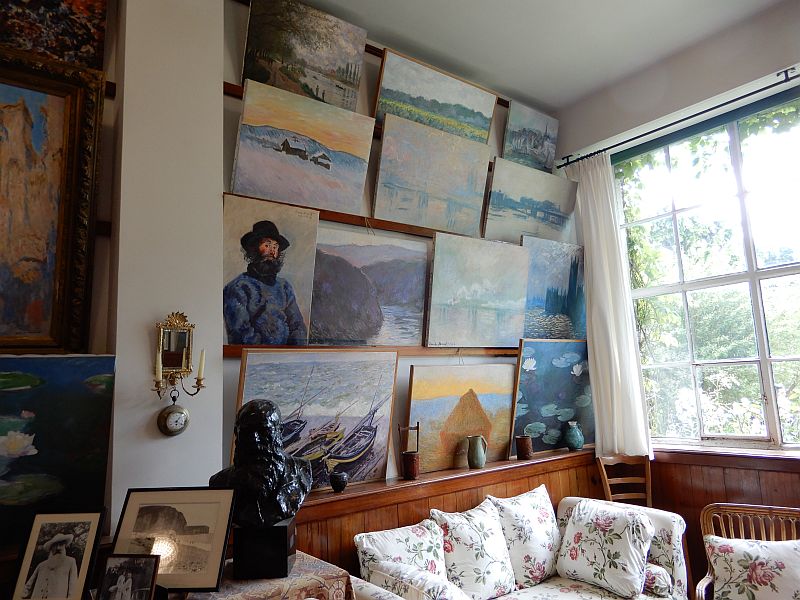 |
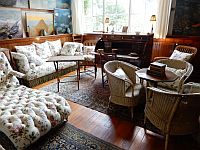 |
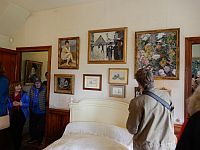 |
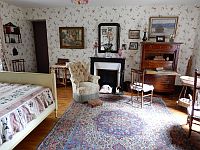 |
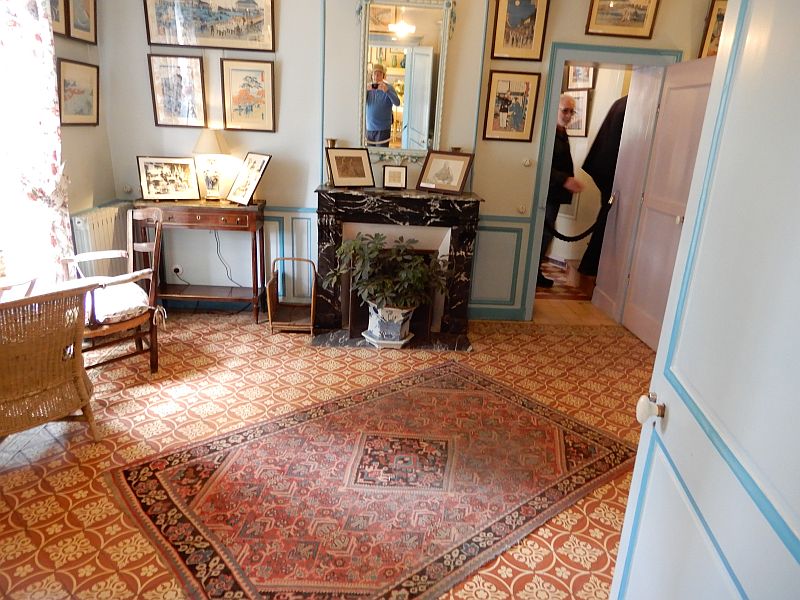 |
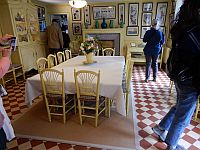 |
 |
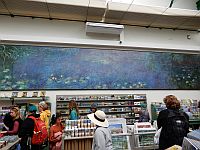 |
The walls of each room in Monet's house were festooned with copies of his famous paintings - as were those of the gift shop! |
|||
We then strolled up the hill to the village church to pay our respects to Monet's family tomb
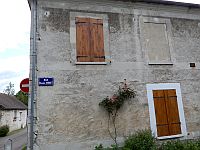 |
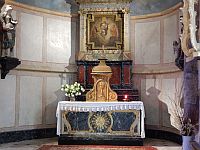 |
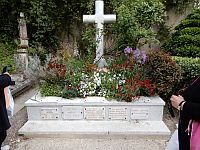 |
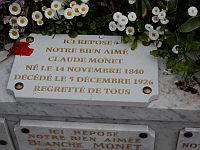 |
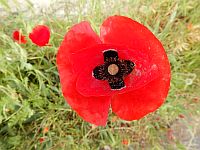 |
I guess this must be the right road |
Inside the charming little village Church |
Outside the church is Monet's family tomb |
I bet that he would have painted this poppy if he'd seen it |
|
Back on board after our wonderful visit to Giverney, we spent a most enjoyable evening with our four new American friends. Over several drinks they taught us how to play a dice game called Farkle which was completely new to us; being in some ways a cross between the traditional dice games and the card game of Poker, it centres largely around how much risk you are prepared to take at each throw, and it certainly made for a evening of great fun.
Meanwhile the ship took us further down the river to Rouen. With our guide we strolled happily around the city, admiring the medieval architecture. The upper floors of the old buildings all seemed to overhang the floors beneath them; we were told that this was because the houses were taxed according to their ground-level size. Unfortunately this had led to the houses almost touching each other at the higher levels which, apart from the health risks when waste matter was tipped out of the upper windows, caused the alleyways to act like chimneys if ever there was a fire, so the system of taxation had been changed to a window tax instead.
Rouen is famous for its cathedral. The building is very impressive but the inside seemed to us to be rather plain, although it did have wonderful stained glass windows as well as some beautiful paintings as well as the tomb of Richard the Lionheart.
Our tour of Rouen was not yet over. We visited the market square where Joan of Arc was martyred (something else that we Brits were to blame for) and admired the brand-new church which is dedicated to her memory. This modern building comprises massive windows of stained-glass that had been recovered from the nearby church which had been destroyed in 1944
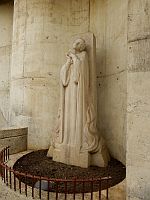 |
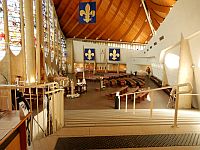 |
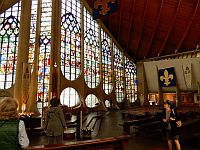 |
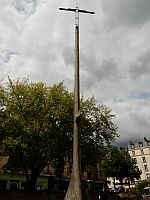 |
Statue of Joan of Arc |
Inside the modern church of St Joan |
The walls are almost entirely stained glass |
A monument to her martyrdom |
The next day was to be the longest one, as were visiting both the Bayeaus Tapestry and the Normandy Beaches. After an early breakfast the coach took us to Bayeux, and it was fascinating to see the Tapestry in its superbly-constructed modern setting. We are very lucky that it has survived for a thousand years; at times there have been plans to display and then burn it, to cut it into many pieces to decorate carnival floats, or simply to throw it away, but now it is clearly displayed behind glass with a detailed audio commentary available. I learned a great deal from the commentary, and was surprised to discover just how much of the tapestry is dedicated to William's explanation of how he had been so badly treated by his family and why he was therefore justified in killing King Harold and invading England. The more I looked at it, the more I wondered how much of this is simply an early example of fake news written by the winner of the battle; similarities with Putin's recent broadcasts after his invasion of Ukraine kept coming into my mind!
We were then taken to a charming old hotel for a superb home-cooked lunch before going forward to the Normandy Beaches. We were a small group of just 8 British and Commonwealth visitors in our coach, as all the Americans were visiting the beaches where the US troops had landed. First w visited the beach at Arromanche which is one of the two sites where Mulberry Harbours had been built to allow goods to be transported to Normandy on and after the D-Day landings. Apparently 9000 tons of materials were unloaded here every day!
We then went to the Canadian museum at Juno Beach and saw a film which was very interesting and extremely poignant. After a short time at Juno beach we drove onwards, past Gold and Sword beaches where the British troops had landed, before continuing to the site of the Pegasus Bridge. The intact capture of this bridge had been crucial to the success of the invasion plans; to achieve the necessary element of surprise the troops had flown to them in gliders which were towed by the Lancaster bombers and launched overhead to land by the bridge and surprise the enemy. The gliders, which were made almost entirely in wood to avoid radar detection, had been secretly delivered to the RAF airfields in self-assembly flat-pack kit-form by a new company called MFI.
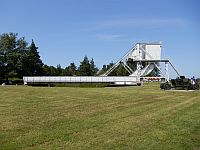 |
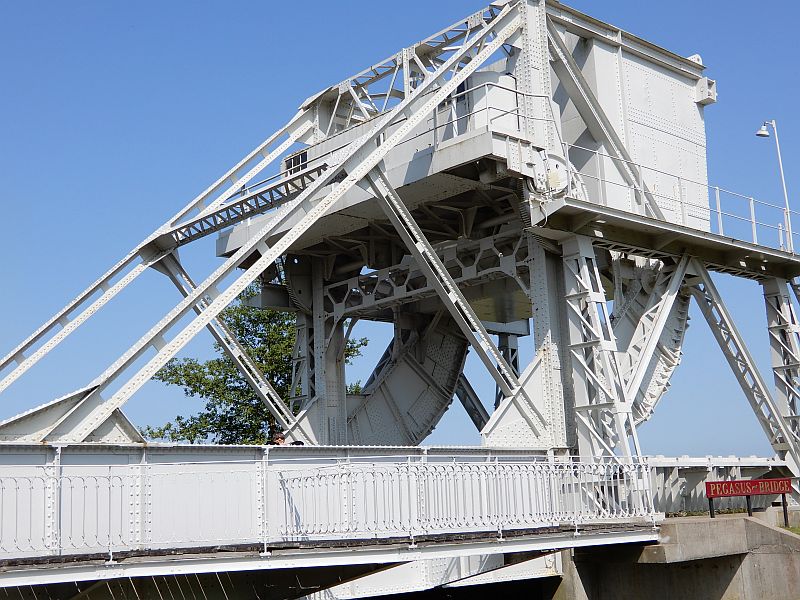 |
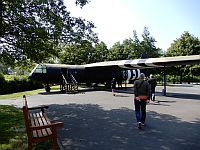 |
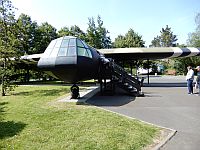 |
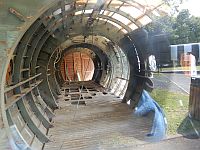 |
The original Pegasus Bridge |
Debbie looks out over the bridge parapet |
One of the wooden gliders which was used in capturing the bridge. It came in kit form. |
The interior of the glider |
|
We then continued to the Commonwealth cemetery at Ranville. Rather charmingly, our tour guide gave us a couple of bouquets courtesy of Viking Cruises; then he played the National Anthem while we all stood to attention. After a minute's silence Debbie laid one of them at the memorial on behalf of Great Britain, and one of the two Canadian passengers laid the other one on behalf of the Commonwealth.
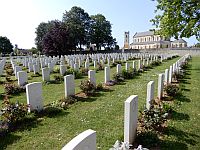 |
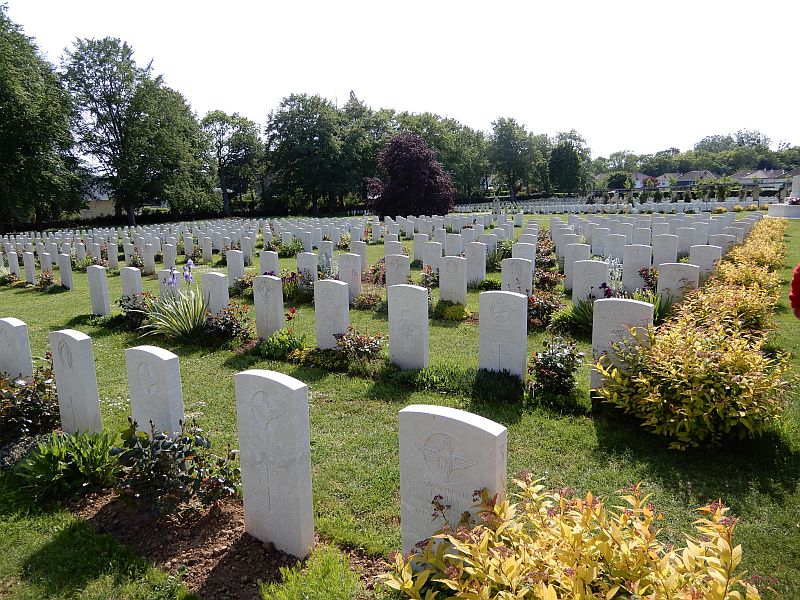 |
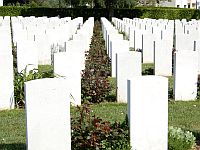 |
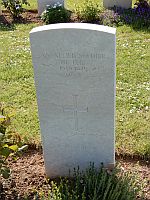 |
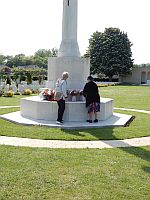 |
The cemetery has the graves of over 2000 British and Commonwealth soldiers. There are rows and rows of gravestones, decorated with roses. |
Not all of them were identified |
Debbie lays a wreath |
||
As the day grew late we returned to the ship, but dinner was even later as we waited for our American friends to join us; they had been delayed because their coach had broken down, but eventually they joined us for a good meal and a birthday celebration for one of them. At the table they presented him with a cake that carried an everlasting candle that could not be blown out, leading us on to a long evening of fun and a very late night.
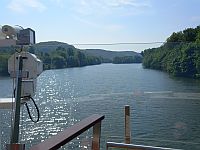 |
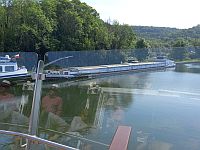 |
 |
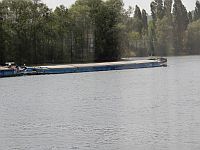 |
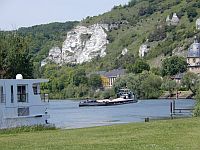 |
We spent a relaxing morning enjoying the beautiful scenery and watching the heavily-laden barges making their way along the river |
||||
The next day we had a lazy morning, enjoying the sunshine on the deck while the ship travelled up the river to arrive at Les Andelys. The village is somewhat dominated by Richard the Lionheart's castle that stands on top of the hill nearby, and we looked at it with trepidation as we knew we would soon be climbing that hill. We were pleased to find that the day's guide was the same person who had shown us around Monet's gardens, for she was a very good guide indeed, as we walked around the village and then, with frequent rest stops in the hot sun, set off to reach the castle. When we reached the top it was obvious why Richard had chosen that spot as it commanded a good view of the river (including a small island where he had installed some cannons) and was almost impregnable atop the hill. Unfortunately it was also therefore highly vulnerable to being besieged, and had been sacked along with much of the village.
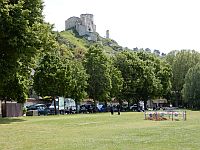 |
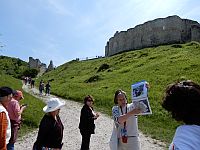 |
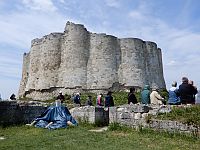 |
 |
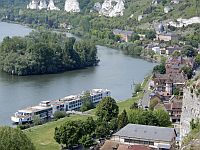 |
Our first view of the castle. It looks like a long climb |
Half-way there. The guide points out the important features |
Nearly there now |
The view from the top |
Ooh look, that's our ship down there |
That evening we relaxed again with our American friends (whom by now we had privately christened 'the Four Musketeers'} as two of them were celebrating their wedding anniversary. We also entered the ship's music quiz as a team of 6; we did really well but came second after being narrowly beaten by the team that included the other two Brits.
The following day we were on the outskirts of Paris, near to Malmaison which had been the home of Napoleon and Josephine. When they split up, she had kept the house for herself until she died. Napoleon had then spent a few days there again after his defeat. We found the house and its original furnishings to be fairly interesting, but for us the highlights were the beautiful gardens that Josephine had created there.
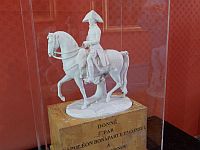 |
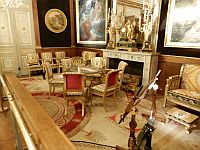 |
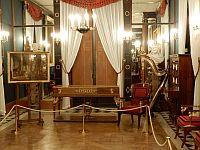 |
 |
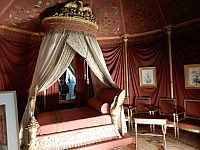 |
The interior of Malmaison, which was Napoleon and Josephine's house |
||||
 |
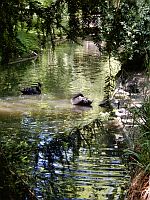 |
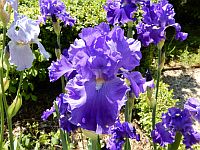 |
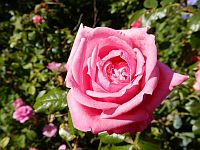 |
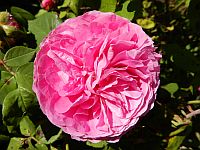 |
The exterior, with black swans on the lake and beautiful flowers in the gardens |
||||
Finally that afternoon we were back on our original mooring in Paris. Later we had our final excursion of the week; a glass-topped boat tied alongside us and we stepped on board for an evening sightseeing trip along the river. By the time we got back to the ship it was fully dark, and the Eiffel Tower looked magnificent - especially for 5 minutes on the hour when it was illuminated with bright sparkling lights,
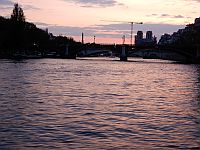 |
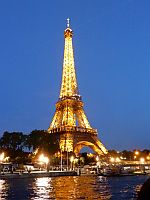 |
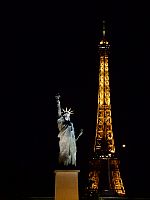 |
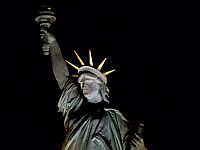 |
Sunset over the Seine |
The Eiffel Tower is lit up |
The Statue of Liberty admires the view of the Eiffel Tower |
The Statue of Liberty in the night sky |
So finally our wonderful trip was over and all that remained was to fly home from Charles de Gaulle Airport - which was easily the most disorganised and chaotic airport that we have ever seen; despite arriving there more than 30 minutes before the check-in desks opened we still only just managed to catch our plane.
We had thoroughly enjoyed our holiday, with two separate weeks that were very similar but at the same time very different from each other, and we came home with a host of wonderful memories including particularly the water-lilies at Monet's garden.
| FlickR album of these photos | Part 1: The River Rhone | |||
| Go to Allan's Page | Our Home Page | Holidays Home Page | British Canals Page | Go to Deb's Page |
All pictures on this site are © Allan Jones unless otherwise stated